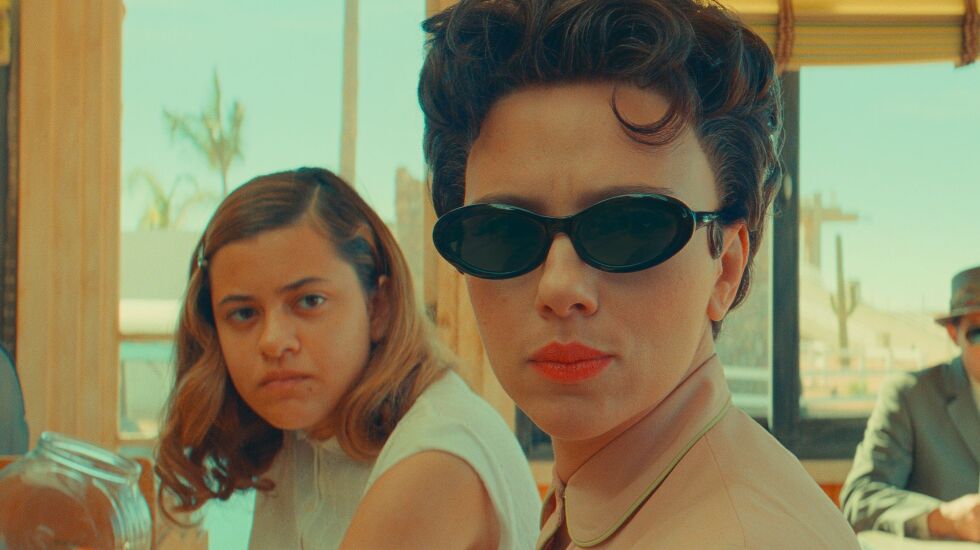
Wes Anderson’s highly stylized, enormously self-pleased, mid-20th century rococo set piece “Asteroid City” contains so many classic Anderson touches that it feels like the kind of movie that characters from other Wes Anderson movies would really enjoy.
No doubt some Anderson aficionados will find the play-within-a-TV-program-within-a-movie presentation to be utterly delightful. For me, it was just too much ado about nothing. As much as I’ve admired so many of Anderson’s exquisitely constructed films, from “Bottle Rocket” to “Rushmore” to “Moonrise Kingdom” to “The French Dispatch,” this particular entry in the Anderson Universe ultimately turns into a star-studded fizzle. It’s a little too precious, a little too look at me, a little too chilly.
There are so many Wes-ian constructs at play here, so many deliberate attempts to keep us at a distance, it’s as if we’re standing on a sidewalk in the rain, looking through a thick window at a painting hanging on a distant wall. We’re too busy thinking about what we’re seeing to feel much of anything at all.
“Asteroid City” kicks off with a black-and-white, Academy-ratio scene with Bryan Cranston as the host of a “Playhouse 90”-type, mid-1950s program about the making of a television play by the famed writer Conrad Earp (Edward Norton), to be directed by the pompous Schubert Green (Adrien Brody). We’ll occasionally revisit that tableau from time to time, but the main story is a dramatization of that play, set in the fictional town of Asteroid City, population 87 — a desert outpost popping with garishly bright colors and some obviously phony background elements. It’s as if a Saturday morning cartoon has been turned into live action, but still feels animated.
With Anderson engaging in his signature whip-pans, we see that Asteroid City consists of a meteorite crater that serves as a tourist attraction; a one-pump gas station; a highway ramp that was halted mid-construction and literally leads to nowhere; a classic, 1950s diner where the kids can drink strawberry milk, and a motor court hotel. (In the distance, there’s the occasional atomic-bomb test mushroom cloud, which doesn’t bother the locals in the least).
A ridiculous roster of A-list stars shows up to play the various quirky, emotionally disengaged characters, most of whom are in town for a series of “Asteroid Day” celebrations, including a ceremony honoring five young “brainiacs” who have created remarkable scientific breakthroughs, e.g., a device that can project the American flag (or an advertising logo) onto the moon. (The visuals in “Asteroid City” are admittedly always a treat.)

And now, some wonderful actors who are clearly having a lot of fun playing deadpan oddballs. Ready? Jason Schwartzman’s Augie Steenbeck is a war photographer and recent widower who has a teenage son named Woodrow (Jake Ryan) and three little girls who think they’re witches. Tom Hanks’ Stanley Zak is Augie’s well-to-do father-in-law, who can’t stand Augie but is willing to take in the family for the sake of the children.
Scarlett Johansson’s Midge Campbell is a Marilyn Monroe-esque movie star who has a terrible history with men and a precocious teenage daughter (Grace Edwards). Maya Hawke is a young schoolteacher trying to keep a handle on a busload of kids on a field trip, Steve Carrell is the officious motel manager who is trying to sell useless plots of lands to his guests.
Matt Dillon is a philosophical local auto mechanic, Tilda Swinton is an uber-nerd scientist, Jeffrey Wright is a speechifying general hosting the stargazer convention, and that’s just a partial list of the A-listers populating the story.
Nearly everyone speaks in a clipped, stage-y, emotionally unaffected tone. A number of major characters in “Asteroid City” are dealing with grief and loss, yet they have almost robotic ways of coping with that.
After an admittedly hilarious stop-motion alien briefly drops in on the proceedings, Asteroid City is put under quarantine, but then let go because we’re running out of movie.
Meanwhile, back in the “real world” New York, Margot Robbie shows up as the actress who was to play Augie’s wife but was cut out of the final teleplay, and Willem Dafoe surfaces as the teacher in an Actors’ Studio-style class, where everyone chants, “You can’t wake up if you don’t fall asleep, you can’t wake up if you don’t fall asleep, you can’t wake up if you don’t fall asleep …”
Don’t tempt me.







